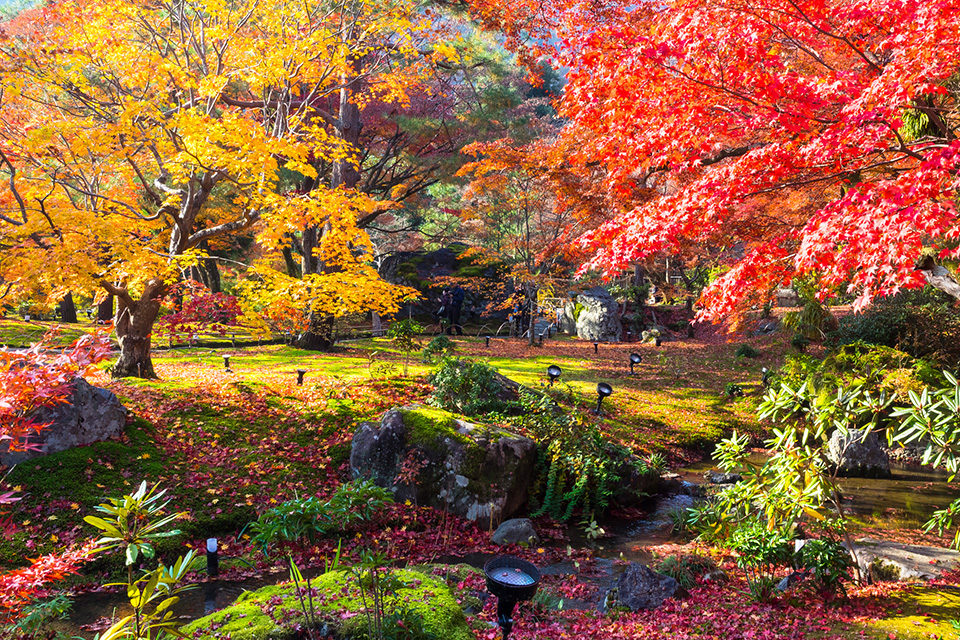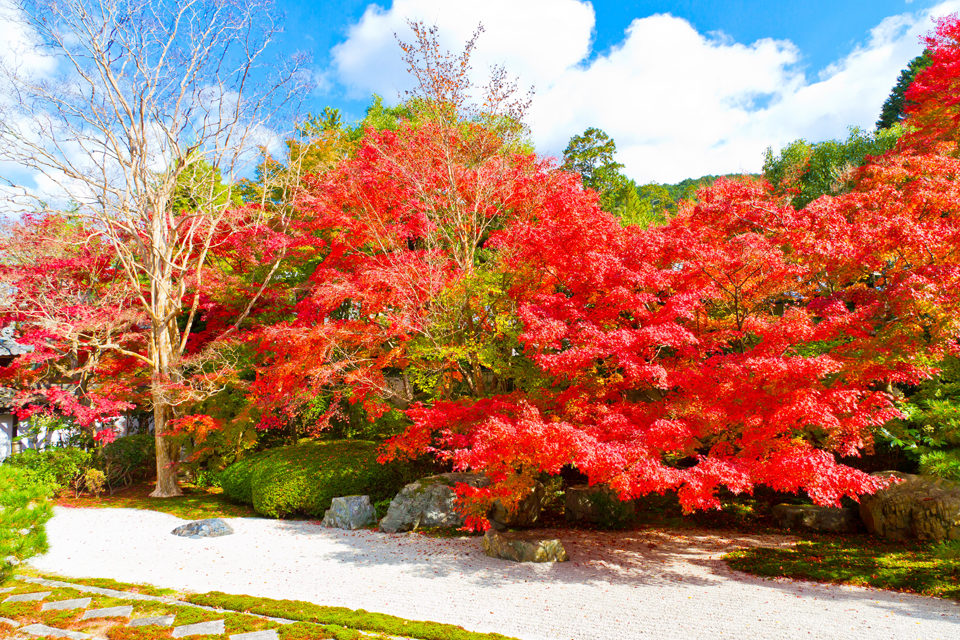
Nanzen-ji Temple was rebuilt on the Rikyu Zenrin-ji Temple of Emperor Kameyama. In the request of Emperor Kameyama, Mukan Fumon, the Daimyo Kokushi (the monk title offered by Emperor) set up this temple. A lot of maple trees were planted in Nanzen-ji. So come to see the red leaves of Nanzen-ji this year.
目次
Where are the places recommended for taking red leaves photos in Nanzen-ji?
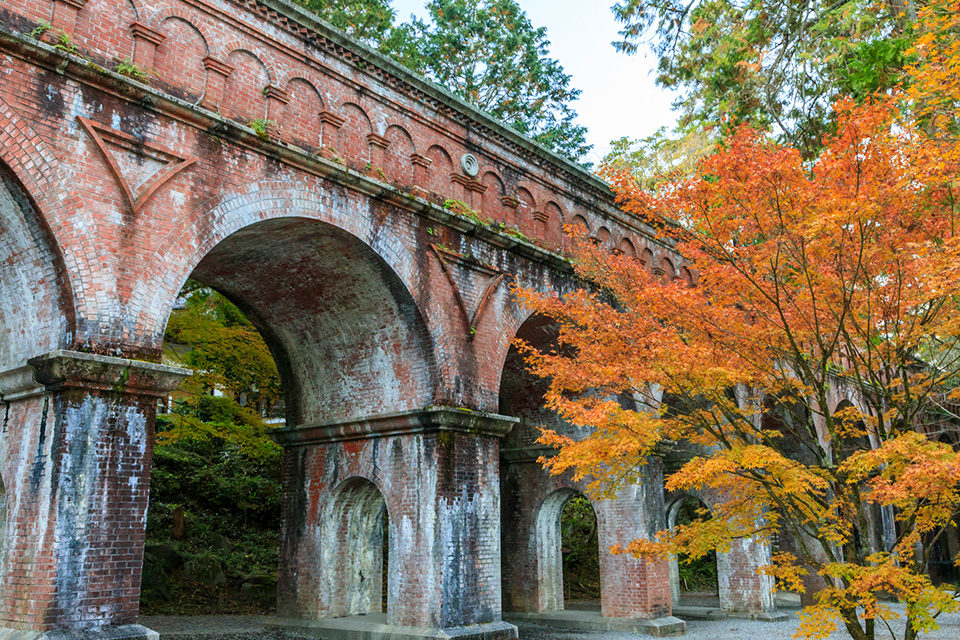 Around main gate Sanmon and along the pilgrimage’s path from Sanmon to main hall, travelers can enjoy the scenery that the chief thief at Sengoku period, Ishikawa Goemon sighed as “Extreme pretty!”. Around the Lake Biwa water divisions that built with red bricks in arch sharp, all are good places for taking red leaves photos.The Honboteien (Garden) is also called as Toranokowatashi. A traditional Japanese garden set up with white sand and 6 different size stones. It looks like a mother tiger bring her young tigers to get across a river. It was a favorite product of Kobori Masakazu, a garden designer in Sengoku Period. It is a nice place for photo taking. And Hojo was a removal building of Seiryoden or royal hall located opposite of female royal family house. The open time for the waterfall is from 9:30am to 3:00pm (Water stop falling during lunch time at 12:00 to 13:00). In the room that can see the waterfall and red leaves in the garden, and at the same time to enjoy the green tea, absolutely a happy event.There are 12 Tatchu sub-temples in Nanzen-ji, the most famous for red leaves are Nanzenin and Tenjuan Temple. They will be opned to public too. Nanzenin is the originator of Nanzen-ji where Emperor Kameyama once used as home. Nanzeni, Tenryu-ji and Koke-dera Temple were reputed as the top 3 historic gardens in Kyoto. In the end of Kamakura period, the royal garden of Emperor Kameyama was designed in kind of promenade garden with pond and fountain. And finally set up by the monk, Muso Soseki.Tenjuan was formed by 2 different style gardens. Southern garden was promenade garden with ponds and fountain. Remain the feature shadow of Nanboku-cho period. Eastern garden was Meiji period style, a new model of Karesansui dry rock garden. To school in Southern garden, need to walk pass the pond where cyprinus carpio swim. Here good to take red leaves pictures. And in Eastern garden, that is white sand built garden. Stone paths with geometry together green moss on top and red maple tree. Photos are with contrast match. [hr][/hr]
Around main gate Sanmon and along the pilgrimage’s path from Sanmon to main hall, travelers can enjoy the scenery that the chief thief at Sengoku period, Ishikawa Goemon sighed as “Extreme pretty!”. Around the Lake Biwa water divisions that built with red bricks in arch sharp, all are good places for taking red leaves photos.The Honboteien (Garden) is also called as Toranokowatashi. A traditional Japanese garden set up with white sand and 6 different size stones. It looks like a mother tiger bring her young tigers to get across a river. It was a favorite product of Kobori Masakazu, a garden designer in Sengoku Period. It is a nice place for photo taking. And Hojo was a removal building of Seiryoden or royal hall located opposite of female royal family house. The open time for the waterfall is from 9:30am to 3:00pm (Water stop falling during lunch time at 12:00 to 13:00). In the room that can see the waterfall and red leaves in the garden, and at the same time to enjoy the green tea, absolutely a happy event.There are 12 Tatchu sub-temples in Nanzen-ji, the most famous for red leaves are Nanzenin and Tenjuan Temple. They will be opned to public too. Nanzenin is the originator of Nanzen-ji where Emperor Kameyama once used as home. Nanzeni, Tenryu-ji and Koke-dera Temple were reputed as the top 3 historic gardens in Kyoto. In the end of Kamakura period, the royal garden of Emperor Kameyama was designed in kind of promenade garden with pond and fountain. And finally set up by the monk, Muso Soseki.Tenjuan was formed by 2 different style gardens. Southern garden was promenade garden with ponds and fountain. Remain the feature shadow of Nanboku-cho period. Eastern garden was Meiji period style, a new model of Karesansui dry rock garden. To school in Southern garden, need to walk pass the pond where cyprinus carpio swim. Here good to take red leaves pictures. And in Eastern garden, that is white sand built garden. Stone paths with geometry together green moss on top and red maple tree. Photos are with contrast match. [hr][/hr]
Lighten-up activities for red leaves in Nanzen-ji Temple
There is no lighten-up event in Nanzen-ji Temple, but in Tatchu sub-temple Tenjuan.The color of red, orange and yellow get twinkle under illumination and like floating on the darkness. The beauty lights up the sky too![hr][/hr]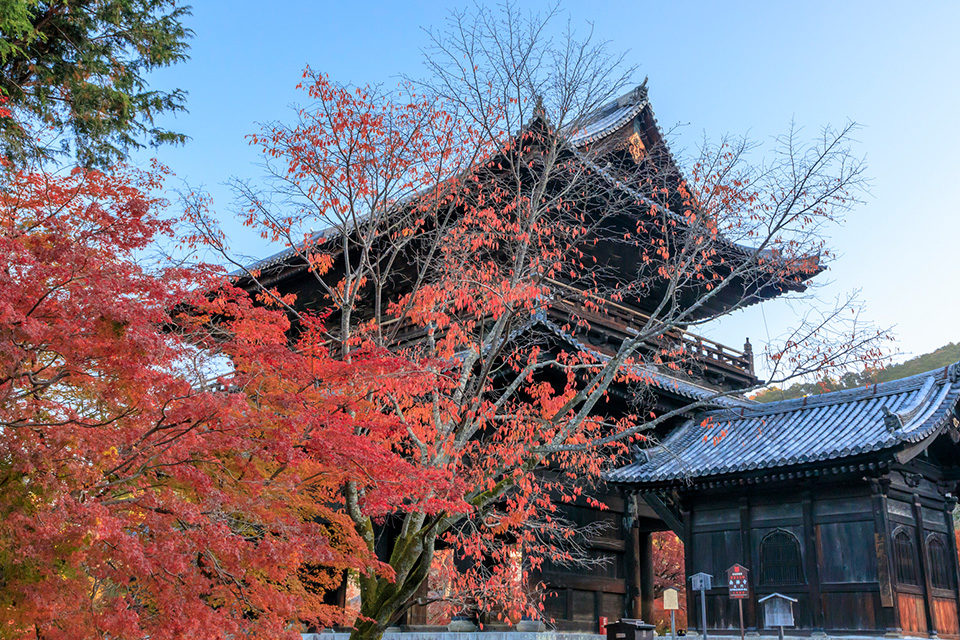
What is the period of seeing red leaves blooming in Nanzen-ji Temple?
Climate varies every year and makes the time change, mostly from late November to early December. A reference is in 2017 November 15 to 30, Tenjuan held the lighten-up event.[hr][/hr]How crowded it will be in red leaves period in Nanzen-ji Temple?
A lot of tourist will travel to Nanzen-ji Temple in red leaves period. Since there is big, so the feeling is not so crowded. Usually the crowded place is from Sanmon to main hall.The 2nd and the 4th week of every month will hold the Kyotoen Zazen event (sitting down in Buddha way and meditation) at Riyouenkaku. From November to March, start at 6:30am and will last for an hour. Travelers can go to Honboteien from the corridor of Riyouenkaku. Since the starting hour is earlier proper opening hours, in case tourists want to enjoy red leaves earlier. This activity is worth joining.If you want to enjoy the night tour in Tenjuan, you can queue up earlier than the event start. Or you can come late (like 1 hour before closure) to enjoy a relatively quiet environment.[hr][/hr]Features of Nanzen-ji Temple
Other than the theme of red leaves, getting off at Keage Station by Subway Tozai Line, there is a tunnel named “Spiral Tunnel” on the way to Nanzen-ji Temple. On top of the tunnel is Keage Inkurain, a famous place for sakura views.The Tatchu sub-temple Konchi-in was built for the 3rd Shogun Tokugawa Iemitsu by the “Black Dress Prime Minister” of Tokugawa Ieyasu, a monk named Ishin Suden. A product of Kobori Masakazu, a Karesansui dry rock garden named “Crane and Tortoise Garden” express the manner of large hearted. Here also the tea house Hassoseki of Enshu for visit.Around Nanzen-ji Temple is famous for tofu soup (boiled bean curd). The shop Okutan and Junsei are well known for this. Take a tofu lunch at here will be a nice choice.Other red leaves sight points around Nanzen-ji Temple
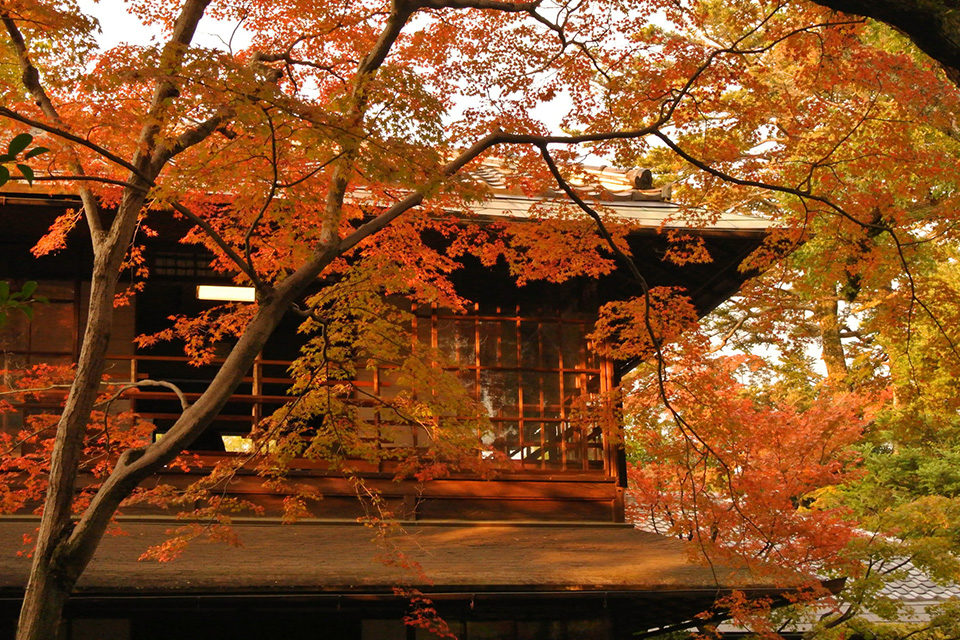
Murin-an
The villa was designed by Yamagata Aritomo who was the prime minister in Meiji period. The garden was made by Ueji Ogawa Jihei VII. The giant rock in the garden was moved by 24 cows from Daigo Mountain. The pond and fountain promenade garden takes water from water divisions of Lake Biwa, and can enjoy the colorful red leaves.[hr][/hr]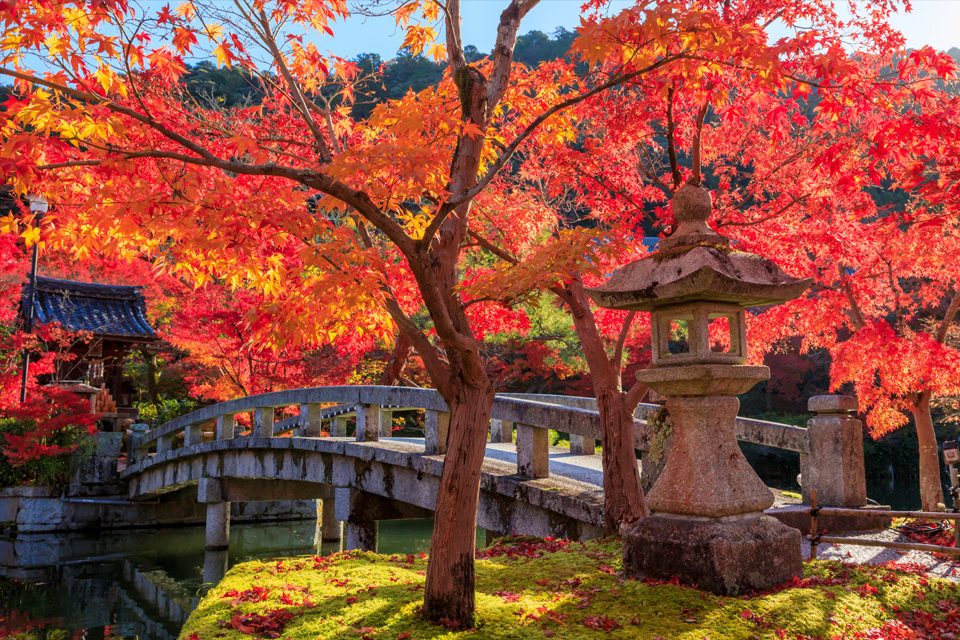
Eikan-do
There represents the red maple leaves in Kyoto. The Hojo Pond reflects the beautiful pagoda and red leaves. There are lighten-up activities in rd leaves period.[hr][/hr]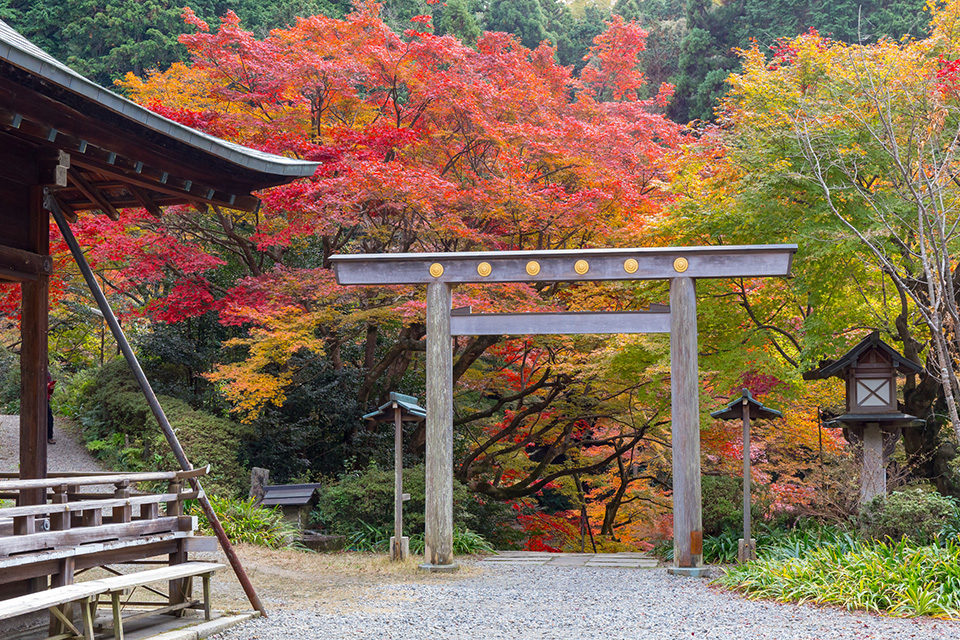
Himukai-Daijingu Shrine
Walking along Keage Inkurain upward is a hidden good place for red leaves. People call here “Ise in Kyoto”. Shrines are made by uncommon Shinmei-zukuri.Opening hours:1st December to 28th February: 8:40am to 4:30pm, 1st March to 30th November: 8:40am to 5:00pm (Last entrance before 20mins)Tenjuan lighten-up event: 15th to 30th November (2017) 5:30pm to 9:00pm (Last entrance at 8:45pm)Fee: Honboteien: 500Yen for adults, 400Yen for high school, 300Yen for secondary and primary schoolSanmon: 500Yen for adults, 400Yen for high school, 300Yen for secondary and primary schoolNanzen-ji Temple: 300Yen for adults, 250Yen for high school, 150Yen for secondary and primary schoolTenjuan: 500Yen for adults, 400Yen for high school, 300Yen for secondary and primary schoolTenjuan lighten-up event: 600Yen for adults, 500Yen for high school, 400Yen for secondary and primary schoolKonchi-in Temple: 400Yen for adults, 300Yen for high school, 200Yen for secondary and primary school,free under 6years old
Address:
Nanzenji FukuchichoSakyo Ward
- Get off at Keage Station by Subway Tozai Line, 10mins walk
- Get off at Higashitennocho Bus Stop or Nanzenji Eikandodo Bus Stop by City Bus, 10 mins walk
- Car park (Car park No.1 of Nanzen Kaikan for private car)
![caedeKyoto[カエデ京都] 紅葉と伝統美を引き継ぐバッグ](https://caede-kyoto.com/wp/wp-content/uploads/2024/07/メインロゴ.png)

